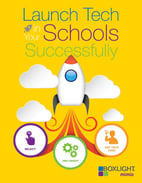
You may think you have determined which technology product is the best fit for your educational needs, but a pilot program is an excellent way to be sure before making that big purchase. It’s a sad truth that more than a few products end up sitting on shelves or taking up space on a server, never to be used. Setting up a successful pilot program is an important part of evaluating classroom technology before spending district funds.
Prior to setting up a pilot, design a pilot process. Schedule a timeline of usage with the vendor, and use that time wisely. Pilots should coordinate with academic calendars, budget discussions, and purchasing time frames. Gather as much data as you can while you have the products. Gather input from all stakeholders, and be sure to speak to your students, as well.
Follow These Steps to Success
- Refer to your tech plan and the tech goals and objectives you developed.
Don’t begin a pilot program of any product before you have determined your school/district needs. Decide how you will collect feedback from teachers and students once the pilot is underway. Make sure you schedule time throughout the pilot program to re-assess needs, and stay on schedule as much as you can. - Determine who will be involved in the pilot.
Include teachers, students, administrators, and IT staff. Your technology committee should work with the group during the entire pilot program. Work closely with the vendor. You should consider the vendor your partner, and work closely with them to make sure they understand your needs. Vendors can offer significant support in piloting, helping you make the right purchases down the line. Make them aware of your objectives and action plans. They should know your buying plans, schedules, time frames for the pilot, and stakeholders participating in the pilot. Involve the vendor in your feedback meetings. Many ed-tech companies are looking for feedback on what works and what needs improvement. In some instances, this feedback prepares them to make changes to their products. - Check your infrastructure.
Before you begin your pilot program, determine whether your current infrastructure can handle necessary additional loads. Also make sure that the programs are supported by your browsers, and note any other issues that might arise. Involving your IT department in the pilot program is an important step for successful planning.
- Prepare formal feedback opportunities.
Make feedback an easy process. Before rolling out the pilot program, create various feedback forms that teachers and students can easily access. Use these feedback opportunities when you need to take note of unexpected occurrences, successes, and the impact on student scores (if applicable). Share these feedback opportunities with the technology committee, the administration, and the vendor. These forms can easily be created and shared using Google Forms. - Support the teachers and students involved in the pilot.
Provide opportunities to support teachers and students during the process. Listen to students and be sure to include them in feedback meetings. Students can often provide insightful information about the programs. Make sure that the educators who are involved get extra time for training with the product. Be supportive of the demands on teachers’ schedules.
- Determine your sustainability plan.
How will you provide ongoing professional development? How will you keep staff current with changes that are occurring? How will you sustain and support the product with repair and maintenance? Involve the vendor in this discussion, as well. They may have helpful suggestions and may be able to refer you to other districts with similar needs.
- Once the pilot ends, gather more feedback.
Lastly, make sure that everyone has their say once the pilot has ended, before any purchase is made. Knowing that their voices were heard will make them feel valued and more likely to rally around the new technology. Address any issues or challenges that are raised. The pilot is your dress rehearsal, which will help ensure that the full roll-out goes smoothly and has the support of all involved parties.
The pilot process is just one component of launching technology successfully in your schools. Want to learn more about the entire process? Drawing on our experts, we have pulled together tips and valuable information on everything from goal setting to getting the tech used. You can find it all in our new guide, Launch Tech in Your Schools Successfully.
Check out the complete guide here.>>




